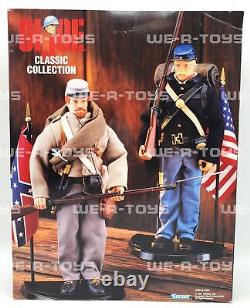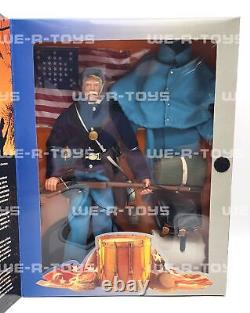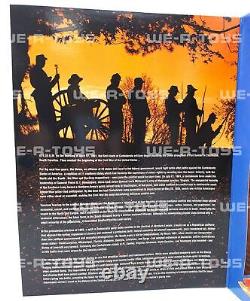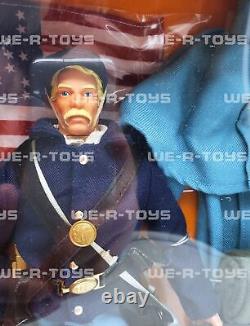G. I. Joe Classic Collection Army of The Potomac Civil War Figure 1997Hasbro NRFB











Joe Classic Collection Army of The Potomac Civil War Figure 1997Hasbro NRFB. This product data sheet is originally written in English. The box has some damage to the cardboard exterior. There are some rubbed corners and a few creases to the outside of the box. On the morning of April 12, 1861, the first blasts of Confederate artillery began pounding the Union stronghold of Fort Sumter in Charleston, South Carolina. Thus marked the beginning of the Civil War of the United States... For the next four years, the Union, an alliance of 23 states still loyal to the federal government, would fight battle after battle against the Confederate States of America, a coalition of 11 southern states, which had declared the supremacy of state's rights by seceding from the Union. Initially, both the North and the South-the Blue and the Gray respectively were sure the conflict would be short-lived. On July 21, 1861, a Confederate force under the leadership of General Pierre G. Beauregard, drove back Union General Irwin McDowell's army at Manassas Junction, Virginia. The unexpected tenacity of the Southern army forced a Northern Army's quick retreat back to Washington, At that point, both sides realized the conflict was to continue for much longer than either had anticipated. By the time the last Confederate army surrendered to Union forces on May 26, 1865, nearly one million Americans were either dead or wounded, making the Civil War the most devastating American conflict ever.
Tensions leading to the conflict between North and the South were a culmination of four decades of intense sectional conflict that reflected deep-seated economic, social, and political differences between the two regions. The agricultural South produced cash crops-cotton, tobacco, and sugarcane-for export to the North and Europe, but it depended on the North for manufactured goods and for the commercial services essential to trade. Underlying the sectional differences, the labor force in the South included nearly 4 million enslaved Africans. Although the slaveholding planter class formed only a small minority of the population, it dominated Southern politics and society.
In the presidential election of 1860, a split in Democratic party ranks resulted in the election of Abraham Lincoln, Lincoln ran on a Republican platform that opposed the further expansion of slavery and endorsed a protective tariff, federal subsidies for internal improvements, and a homestead act. By March 1861, when Lincoln was inaugurated, seven states-South Carolina, Mississippi, Florida, Alabama, Georgia, Louisiana, and Texas-had adopted ordinances of secession, and the Confederate States of America was formed. Following the Confederate victory at Ft. Sumter, Virginia, Arkansas, North Carolina, and Tennessee also seceded - and so the battle lines were drawn for the ensuing conflict.
The young soldiers of the war fought during an era that straddled modern and traditional warfare. While more advanced weaponry such as the Sharps Carbine began replacing commonly used Springfield single-shot muzzle-loader rifles, battalions continued to enter combat in close-order formations. Making themselves easy targets for musketballs and cannon-tire.Uniforms were poorly made and offered little protection, and shoes and boots were often coveted items. The importance of antiseptics in the treatment of infections was not yet well understood, resulting in more deaths from infection and disease than from actual combat. Soldiers often wrote their names or initials on handkerchiefs or strips of cloth and pinned them to their uniforms before going into battle, providing the basis for the dog tags used by 20th century armed forces. It is on this backdrop of extreme hardship that the most memorable military event in the history of the United States painted itself in the blood of the nation's young men. Blonde hair, blue eyes, and accessories.
EQUIPMENT LIST: ENLISTED OVERCOAT, TENT, WOOL JACKET, TROUSERS, COTTON SHIRT, STAKES, BEDROLL, FORAGE CAP, KNAPSACK, TIN CUP, SHOES, SOCKS, BELT, CANTEEN, POUCH, STAND, BASE, 1853 ENFIELD RIFLE MUSKET, BATTLE STANDARD FLAG, CARTRIDGE BOX & SLING, 6 CARTRIDGES, BAYONETT & SHEATH. Notice The box for this item will have some shelf wear or creasing. If this is a multiple quantity inventory listing, the listing photos are representative of the condition of the item, however the condition of each box will vary slightly. Please zoom in on photos to see more condition details.Thanks for shopping with Keith & Deb at. All of our items are from a clean, smoke free, pet free environment. We care about our customers! Soldiers often wrote their names or initials on handkerchiefs or strips of cloth and pinned them to their uniforms before going into battle, providing the basis for the dog.

